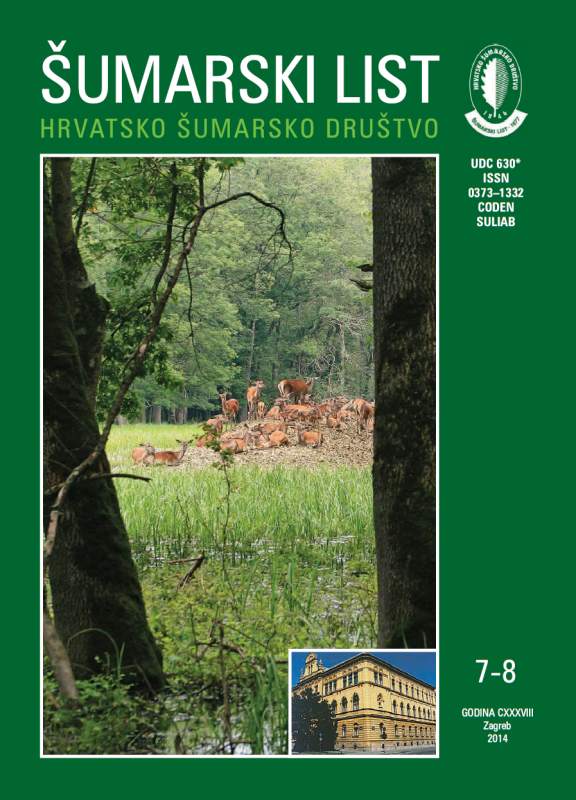
broj: 7-8/2014
pdf (9,19 MB) |
|
||||||||||||||
| RIJEČ UREDNIŠTVA | ||
| Uredništvo | ||
| THE EDITORIAL MISSION pdf HR EN | 361 | |
| IZVORNI ZNANSTVENI ČLANCI | ||
| Albert OFNER, Marijan GRUBEŠIĆ, Krešimir KRAPINEC, Dean KONJEVIĆ | UDK 630*156 (Capreolus capreolus L.)(001) | |
| COMPARATION OF BODY AND TROPHY DEVELOPMENT OF ROE DEER (Capreolus capreolus L.) IN HUNTING GROUNDS IV/9 "POKUPSKI BAZEN" AND IV/22 "PETROVA GORA" pdf HR EN | 363 | |
| Branislava BATOS, Darka ŠEŠLIJA JOVANOVIĆ, Danijela MILJKOVIĆ | UDK 630*181.8 (Quercus robur L.)(001) | |
| SPATIAL AND TEMPORAL VARIABILITY OF FLOWERING IN THE PEDUNCULATE OAK (Quercus robur L.) pdf HR EN | 371 | |
| Summary Climate change, as well as biotic and abiotic stress environmental factors and the exploitation of oak forests have the greatest impact in reducing the pedunculate oak areas. These factors on one side reduce the pedunculate oak living area, while on the other side they create unfavorable conditions for its renewal. In the last decades, there has been an attempt to change this situation, primarily by planting appropriate provenances and more resistant varieties. Knowledge of the phenological variability is one of the essential elements useful in separation of genotypes better adapted to changing environmental conditions. One of the phenological studies of the pedunculate oak implied the analysis of the pollination time as one of the intermediate phase of the flowering phenophase. Observations were carried out in two populations at two locations in the area of Belgrade (Serbia), "Ada Ciganlija" and "Bojčinska šuma", a total of 58 trees (29 trees per location) in three consecutive years (2004, 2005, 2006). According to the ANOVA results differences between locations and years were statistically significantly (all p <0.0001). Time of pollination in the location of "Bojčinska šuma" was earlier compared to location "Ada Ciganlija" in all three years of observation. The obtained time difference gives rise to the assumption that there are different varieties of the pedunculate oak: the "early" and the "late" one. According to the phenological pattern of population, the majority of trees maintain the same trend from year to year, i.e. remain in the same phenological group (labeled as "early", "average" and "late"), or change it for one phenological level, suggesting the genetic influence on the expression of this trait. Since those populations are located in similar environmental conditions, obtained differences between them can be regarded as a consequence of intraspecific variability of the pedunculate oak and of the genetic structure of population. Key words: phenological variability of flowering; Quercus robur; pollination | ||
| Saša ORLOVIĆ, Srđan STOJNIĆ, Andrej PILIPOVIĆ, Saša PEKEČ, Milan MATARUGA, Branislav CVJETKOVIĆ, Danijela MILJKOVIĆ | UDK 630*161+232.3 (Prunus avium L.)(001) | |
| VARIATION IN LEAF PHOTOSYNTHETIC TRAITS OF WILD CHERRY (Prunus avium L.) FAMILIES IN A NURSERY TRIAL pdf HR EN | 381 | |
| Milan DREKIĆ, Leopold POLJAKOVIĆ PAJNIK, Verica VASIĆ, Predrag PAP, Andrej PILIPOVIĆ | UDK 630*453+151 (Stereonychus fraxini De Geer)(001) | |
| CONTRIBUTION TO THE STUDY OF BIOLOGY OF ASH WEEVIL (Stereonychus fraxini De Geer) pdf HR EN | 387 | |
| PRETHODNO PRIOPĆENJE | ||
| Damir DRVODELIĆ, Milan ORŠANIĆ, Vibor ROJE, Marko TEPŠIĆ | UDK 630*232.3+164 (Picea abies L., H. Karst) | |
| MORPHOLOGICAL PROPERTIES OF NORWAY SPRUCE (Picea abies L., H. Karst.) IN DIFFERENT pH SOLUTIONS pdf HR EN | 397 | |


